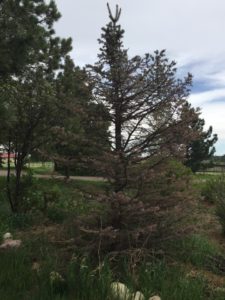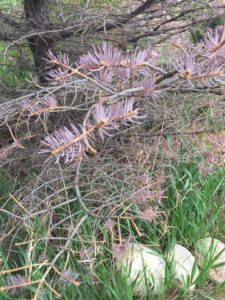 After we moved into our neighborhood the stories slowly came out of the woodwork about our house’s former owner. Mary Ellen was quite the eccentric woman, and so we heard on more than one account that she never mowed the lawn. In fact, it appeared that she really didn’t see up much around the property except her horses. That’s why it has been so heartbreaking this year to see three of our spruce trees die.
After we moved into our neighborhood the stories slowly came out of the woodwork about our house’s former owner. Mary Ellen was quite the eccentric woman, and so we heard on more than one account that she never mowed the lawn. In fact, it appeared that she really didn’t see up much around the property except her horses. That’s why it has been so heartbreaking this year to see three of our spruce trees die.
You see, when we moved in, we trimmed the trees, mulched around the trees, watered and cared for the yard. We’ve put hours upon hours into making the yard look good and improve the property’s value. So, you can feel my pain when some of our nice mid-size and mid-height trees (that provided great privacy in the yard) died suddenly.
It all started with just one of these spruce trees going from green to brown and needle-less within a couple weeks around the end of winter this year. Then we turned around and a second tree was browning up in front of our eyes. Within weeks a third has gotten sick. That’s when I knew this is something to look into.
People sometimes wonder why we do a lot of things for ourselves. If you hang around us long enough, you’ll realize that we are constantly learning how to take care of various issues ourselves. And while there’s definitely a monetary benefit to doing things yourself, one of the biggest reasons we figure thing s out is because people rarely provide the answers or help we need. We’ve found, more often than not, that the Internet and some trial and error provide what we need, instead of hiring others. Sad, but for us, often true.
s out is because people rarely provide the answers or help we need. We’ve found, more often than not, that the Internet and some trial and error provide what we need, instead of hiring others. Sad, but for us, often true.
The trees have proven to be one of these situations. While I didn’t hire paid help, I DID go check out the CSU Extension Office in our county. I cut off two branches (a good one and a dead one), hoping that these master gardeners would take one look and know exactly what was going on. Instead, they told me that it was probably a water issue, combined with the stress of the major temperature swings we had this winter/spring. Now, when you live in a high desert climate, that makes some sense, but when all of the other trees in your yard are doing fine that doesn’t hold up. Not only that, when I came home from this consultation I checked the one tree that is ‘in-process’ of dying. This tree was still green at the top and losing needles/branches at the bottom of the tree first. Again, not a water issue because trees that are too dry stop pulling water to the top of the tree first as they die.
Clues:
- Three spruce trees have gone brown, and lost most of their needles.
- Trees are between 3-5″ in diameter at the base.
- No other species of tree seem to be affected so far.
- Two of three trees are in front yard (no herbicides used) and one affected tree is in back yard (where some herbicides have been used, but not directly within a few feet of tree)
- The tree we’re paying attention to is still green at the top and dying on the bottom first.
- Trees had no trauma to roots outside of wind (which they’ve had every year of existence)
Spruce Sleuth Conclusion #1: Not a water issue.
Spruce Sleuth Conclusion #2: Not a trauma issue.
Since the master gardeners didn’t have an answer, I took to the Internet. I came across Rhizophaera, which is a fungal disease in spruce trees. Rhizosphaera starts on the inner and lower growth and progresses upward through the tree. Apparently this disease can take up to 15 months to show visible symptoms. It can kill young trees, but it sounds like mature trees may bounce back (though look really strange).
Rhizophaera infections can spread when spores from infected needles fall to the ground are are splashed onto uninfected needles.
Plan of attack:
- Spray up to three spray applications of a fungicide such as Manzate to help protect newly forming needles on the trees in our yard that look like they may be next. It acts as a protective barrier, stopping spores from infecting the needle surface.
- Rake up as much of the fallen needles as possible below the infected trees and move them out of the immediate yard to protect other spruce trees in our yard.
- Watch and see. This may be an issue we have to monitor for the next few years, but I’d hate to lose more of our spruce trees. So far, the ones we lost were smaller, but we have others that are HUGE and I’d hate to lose the privacy they provide.
We’re still in the thick of this issue. If you have experienced similar issues, I would LOVE to hear what worked for you. Sadly, when you have to figure stuff out yourself, sometimes you make mistakes or don’t know all of the information. Of course, that’s also how you learn, but if we can learn from you, we would love to!
While the master gardeners at the extension office weren’t overly helpful with my specific problem I learned two great little nuggets from them:
- Keep mulch about 6″ away from the base of the tree trunk. This keeps bugs that love living in the mulch away from the bark some and helps prevent destructive beetles from wanting to get too close to your tree.
- If you replant in the same vicinity of the infected trees, plant a different species of tree. You’ll prevent the new tree from being vulnerable to the same prior infection.
